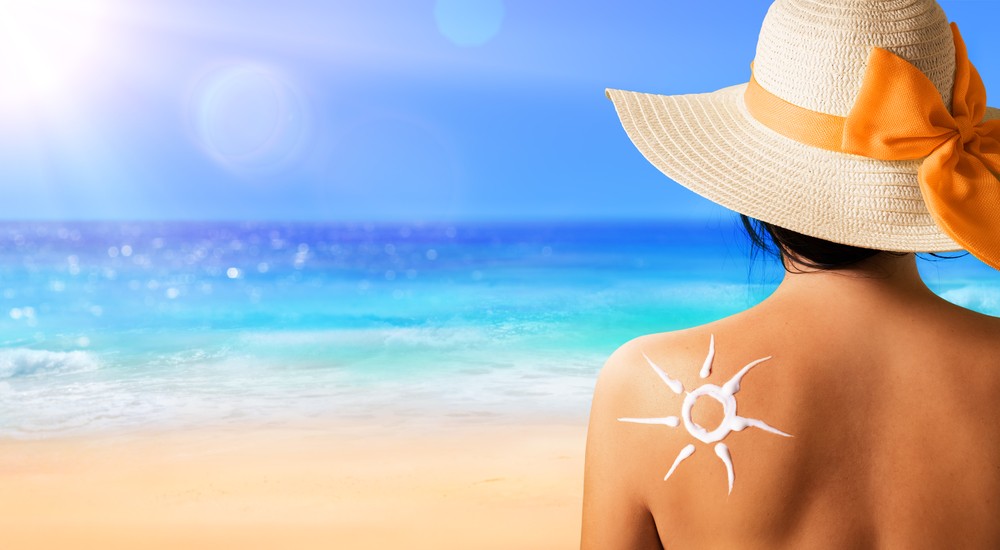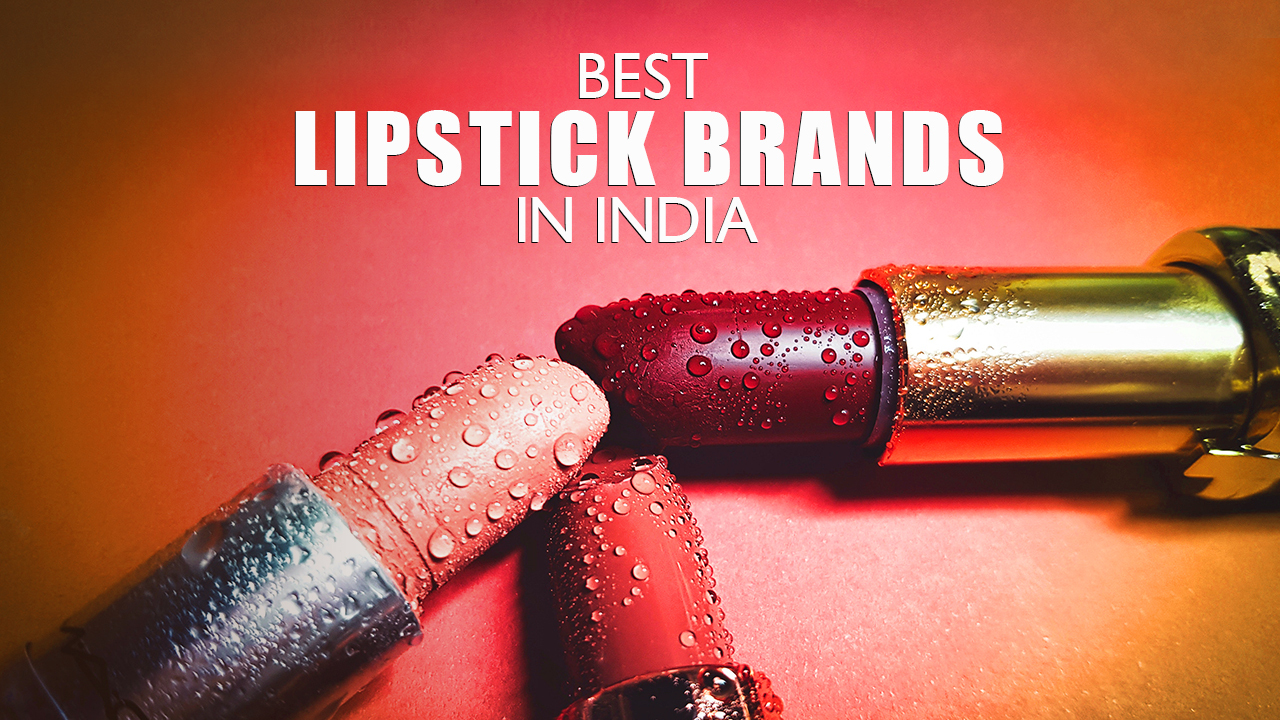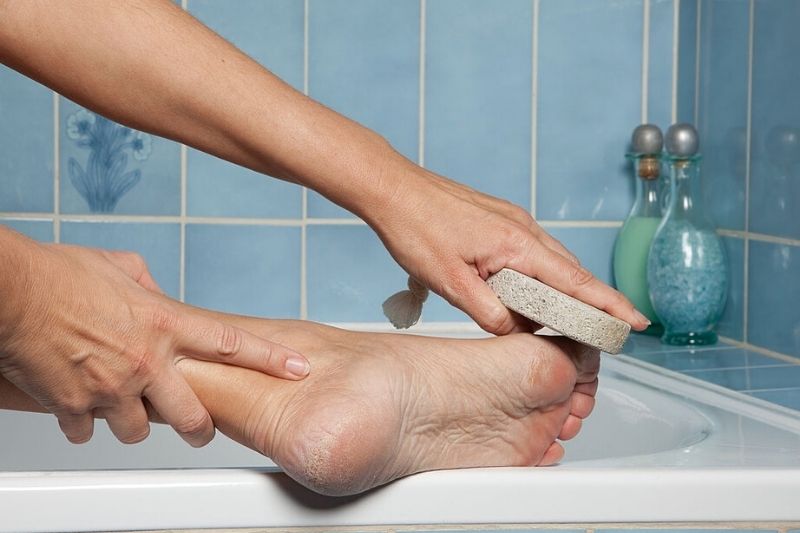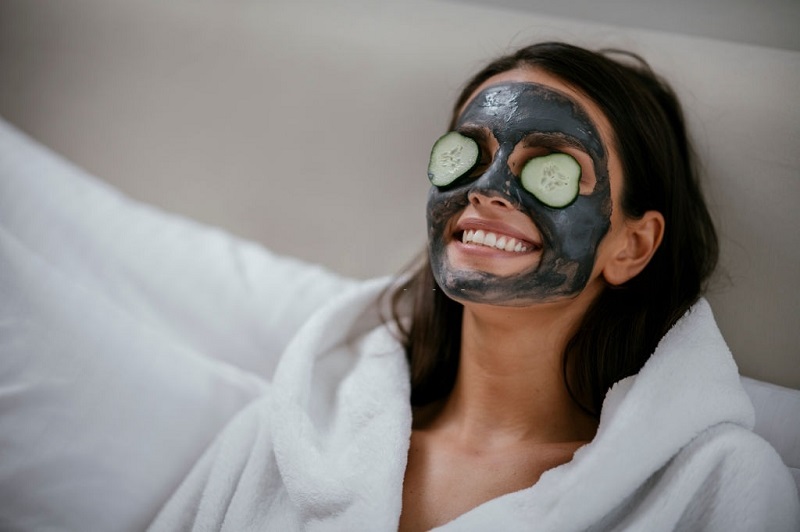Are you looking for the best sunscreen lotion in India for your skin type? Well if that’s the case then you are at right place. In this article, we will not only help you choose the best sunscreen lotion but also help you understand why sunscreen lotion is important for your body & face.
After the cold and rain of the winter months, there is nothing more pleasant than exposing yourself to the heat of the sun. In addition to giving the skin a golden tint, the sun’s rays improve mood and help the body in producing the precious vitamin D.
Too often, however, we forget that exposure to the sun can also involve great risks too, especially if it is too prolonged or carried out without adequate protection. In these cases, in fact, the action of the sun’s rays represents a risk not only in aesthetic terms, causing the early appearance of wrinkles, skin spots and other signs of aging, but also for health, leading to serious diseases such as melanomas and skin cancers.
One of the most common and effective methods to protect yourself from the harmful effects of the sun and to tan safely is to use a good sunscreen.
The most important things in a nutshell
- The level of protection of solar filters is indicated by the Solar Protection Factor (FPS or SPF from Sun protection factor). Sunscreen contributes to the prevention of skin cancer and skin aging.
- There are various types of sunscreen, depending on their mechanism of action, format and specific properties.
- It is recommended to use sunscreen every day. If you go out in the sun to tan, we recommend that you apply it 30 minutes before exposure and every 2 hours thereafter.
List of Top 10 Best Sunscreen Lotion in India 2024
There are various factors that one should look for before buying a sunscreen lotion such as SPF, skin type, effectiveness, etc. It is important to choose the right sunscreen lotion for your body. Hence, we’ve curated a list of top 10 best sunscreen lotion available in India. You can either choose a sunscreen lotion from this list or you can skip this part move down further to better understand how to choose a sunscreen lotion for your skin type.
| S. No. | Best Sunscreen Lotion in India | Price |
| 1. | Neutrogena Ultra Sheer Dry-Touch Sunblock (SPF 50+) | Rs. 217 |
| 2. | RE’ EQUIL Oxybenzone and OMC Free Sunscreen (SPF 50) | Rs. 460 |
| 3. | Lotus Safe Sun UV Screen Matte Gel (SPF 50) | Rs. 339 |
| 4. | Biotique Morning Nectar Sun Protect Moisturizer (SPF 30+) | Rs. 169 |
| 5. | Khadi Naturals Herbal Aloe Vera Sunscreen Lotion (SPF 30) | – |
📌 Certain body lotions can also be used as sunscreens. However, be aware that these usually have an SPF of 15 or less and provide only limited protection against the sun’s harmful rays. To know more, read our articles about best nivea body lotion for winter and best vaseline body lotion for winter.
Top 5 Best Sunscreen Lotion In India For Both Oily & Dry Skin
- Neutrogena Ultra Sheer Dry-Touch Sunblock, SPF 50+
- RE’ EQUIL Oxybenzone and Zero-Omc Sunscreen for Oily, Sensitive and Acne-Prone Skin, SPF 50 PA+++
- Lotus Herbals Safe Sun UV Screen Matte Gel, SPF 50
- Biotique Bio Morning Nectar Sunscreen Ultra Soothing Face Lotion, SPF 30+
- Khadi Herbal Aloe Vera Sun Expert SPF 30 PA Fairness UV Sunscreen Lotion
1. Neutrogena Ultra Sheer Dry-Touch Sunblock, SPF 50+
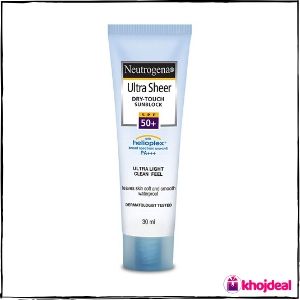
Notable features of this sunscreen lotion
- Quantity: 30ml
- Leaves skin soft and smooth
- Oil-free
- Waterproof
- Sweat-proof
- Resists rub-off
- SPF 50+ sunscreen to help prevent sunburn
- Contains Oat Kernel Extract
- Equipped with exclusive Helioplex technology
- Dry-touch feature lends matte effect
- Nourishes skin apart from lending UV protection
- Skin Type: Combination skin, Normal skin
- Container Type: Tube
2. RE’ EQUIL Oxybenzone and Zero-Omc Sunscreen for Oily, Sensitive and Acne-Prone Skin, SPF 50 PA+++
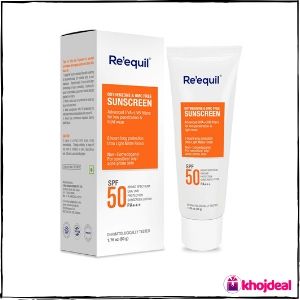
Notable features of this sunscreen lotion
- For oily, sensitive and acne prone skin
- Non-comedogenic
- Dermatologically tested
- Clinically proven ingredients
- Advanced UVA & UVB filters for low penetration
- Non-greasy matte finish
- Long protection
- Oxybenzone and OMC free cosmeceutical formulation
- SPF 50 with PA+++
- Ultra-light
- Continuous sun protection with a single application
- Absorbs easily without penetrating deep into the skin
3. Lotus Herbals Safe Sun UV Screen Matte Gel, SPF 50
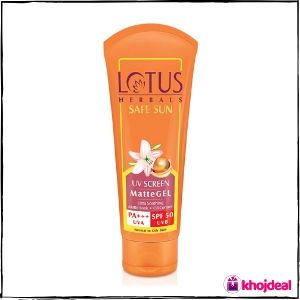
Notable features of this sunscreen lotion
- Quantity: 100g
- Item Form: Cream
- Sebum Control Vanilla (Vanila Plamifolia)
- Soothing Horse Chestnut (Trapa Bispinosa): UV Protector
- Skin Type: Normal To Oily
- Ultra soothing matte effect
- Provides effective solutions to skin tanning
- Protects skin from generating wrinkles
- Prevents skin from drooping
4. Biotique Bio Morning Nectar Sunscreen Ultra Soothing Face Lotion, SPF 30+
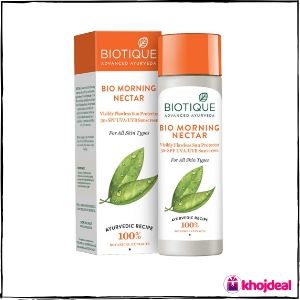
Notable features of this sunscreen lotion
- Quantity: 120ml
- Item Form: Lotion
- Protects skin with SPF 30 UVA / UVB sunscreen
- 100 percent natural
- Skin Type: Suitable For All Skin Types
- Replaces natural oils and replenishes lost moisture
- Softens and brightens skin for a noticeably fairer complexion
5. Khadi Herbal Aloe Vera Sun Expert SPF 30 PA Fairness UV Sunscreen Lotion
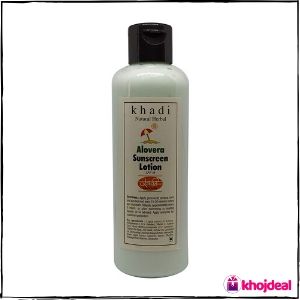
Notable features of this sunscreen lotion
- UV protector
- Skin Type: Normal To Oily
- Item Form: Cream
- Non-greasy
- Fast-absorbing lotion
- Provides natural, full-spectrum protection against UVA / UBA rays
- Provides a balanced & effective solution for a lighter, fairer & even skin tone
- Helps to leave your skin nourished & protected
How do sunscreens work?
Referring to the wavelength, we can distinguish three types of radiation emitted by the sun: visible light, infrared and ultraviolet (UV) rays, and it is precisely against the latter that sunscreens act. In fact, penetrating the skin, UV rays stimulate tanning and the production of vitamin D, but they can also prove extremely harmful.
To be precise, there are three types of ultraviolet rays, which are also distinguishable by their wavelength: UVA, UVB and UVC. The latter are largely shielded by the ozone layer that envelops the Earth; UVA rays, on the other hand, can penetrate into the deep layers of the skin, aging the tissues and weakening the immune system, while excessive exposure to UVB rays, which stop at the first layer of the skin, can cause sunburn, sun rashes and, in the worst case scenario, skin cancers.
Sunscreens contain particular substances which protect the skin by absorbing, reflecting or diffusing UV rays. Depending on the active ingredient they contain, sunscreens are commonly divided into two groups:
- Chemical sunscreens: These are substances such as Benzophenone-3, Octyldimethyl-PABA and Octyl-Methoxycinnamate, which protect the skin by capturing the energy of UV rays and transforming it into heat;
- Physical sunscreens: The most used are zinc oxide and titanium dioxide which, when spread on the skin, act as a real shield, reflecting the UV rays so that they cannot penetrate the skin.
Many experts, however, point out that this distinction is improper or even misleading, since all the substances used as sunscreens are in fact chemical compounds; the only difference is that the so-called physical filters are generally inorganic and insoluble, that is to say that once applied they present themselves as particles, leaving the characteristic whitish layer on the skin.
📌 Excessive exposure to the sun can result in wrinkles, sagging skin, and age spots. To help prevent these effects, it is important to use sunscreen when outdoors and to limit your time in the sun. Additionally, the best anti aging cream in India for 40s can also be used to help keep your skin looking young and healthy.
Sunscreen Buying Guide – How To Choose a Sunscreen For Your Skin Type?
To date, the cosmetic companies that offer this type of products are many and, therefore, there are many brands, types and price ranges to choose from. So, how to understand which product is really right for us? In this buying guide we will clarify a little about this, examining the main factors to pay attention to in order to identify the sunscreen that best suits your needs and, above all, those of your skin.
The sun protection factor or SPF
One of the most important characteristics of sunscreen is its protection factor, also known as SPF. It is a numerical value that expresses how much the time of exposure to the sun can be increased before a sunburn occurs. This means, for example, that a sunscreen with a protection factor of 50 should allow the skin to be exposed to the sun’s rays for a period that’s 50 times longer than that normally expected.
The higher the sun protection factor of a cream, the greater the product’s ability to delay the sunburn. Most sunscreen products currently on the market cover a range from SPF 6 to SPF 100. However, no product can guarantee 100% protection from the risks associated with UV rays. Let’s see in detail which protection band the most common protection factors correspond to:
- SPF 6-10: low protection;
- SPF 15-20-25: medium protection;
- SPF 30-50: high protection;
- SPF 50+: very high protection.
However, it should be specified that the protection capacity of a cream does not increase linearly as the protection factor increases. Therefore, by purchasing a cream with an SPF of 30, we should not expect double protection compared to that offered by the sunscreen with a SPF 15.
A cream with an SPF 15 blocks 93% of UV rays, a value that rises to 97% with an SPF 30. Finally, a sunscreen with SPF 50 manages to shield 98% of radiation.
Sunscreens with a high protection factor, therefore, actually protect more, but the real difference is not so relevant. for this reason, once you have chosen the most suitable protection factor for your needs, it is equally important to make sure to use protection properly.
It is also important to point out that the protection factor refers exclusively to UVB rays. In fact, there is no standard method for calculating the protection factor against UV-A rays. This is due to the fact that radiations of this type, penetrating deep into the skin, do not cause skin redness, one of the main parameters used in the calculation of the SPF.
Therefore, we recommend focusing on sunscreens that shield both UVB and UVA rays. To recognize them, simply check that the wording “UVA” or “broad spectrum” appears on the packaging.
Phototype
The second factor to consider before buying a sunscreen is your skin type. It is a classification used in dermatology, which takes into account individual physical characteristics such as ethnicity, eye color, hair color and type of reaction to exposure to ultraviolet rays. The Fitzpatrick classification identifies six phototypes:
- Phototype I: Light blond or red hair, light eyes, very light complexion which tends to develop erythema if exposed to the sun;
- Phototype II: Blond or light brown hair, light eyes, light complexion that tends to burn easily;
- Phototype III: Dark hair, medium complexion that burns occasionally;
- Phototype IV: Dark hair, complexion tending to dark which rarely burns;
- Phototype V: Dark hair and eyes, olive complexion that burns very rarely;
- Phototype VI: Dark hair and eyes, very dark / black complexion that never burns.
The higher the phototype, the higher the amount of melanin present in the skin and the lesser protection you’ll need from the sun’s rays. So, you can choose a low protection band.
If, on the other hand, the phototype is low, the skin contains a low amount of melanin and, consequently, the risk of reaction to sunlight will be higher. In this case, therefore, it is necessary to opt for a high protection. Therefore, indicatively, the choice of sunscreen based on the skin type can be based on the following guidelines:
- Phototype I: very high protection;
- Phototype II: very high / high protection;
- Phototype III: high / medium protection;
- Phototype IV: high / medium protection;
- Phototype V: medium protection;
- Phototype VI: medium / low protection;
Skin Type and Sunscreen formulas
Nowadays it is possible to find commercially available sunscreens with various formulas and textures. The third factor to consider when you want to buy a sunscreen, therefore, is your skin type: based on normal, dry, oily or combination skin, in fact, we will have to prefer one formula over another.
Let’s see in detail what are the main types of sunscreen products currently on the market:
- Cream: It is more likely to be the most classic and widespread sunscreen. It is characterized by a dense and full-bodied consistency which makes it a little more difficult to spread, which is why it must be worked with the hands for a long-time during application. On the other hand, precisely because it is very dense, this type of sunscreen is characterized by good adhesion and resistance on the body. Some sunscreens of this type are a bit oily and may not be ideal on particularly oily or shiny skin. In general, this type of sunscreen is perfect for those who have skin that dries easily.
- Milk: Milk differs from cream only in terms of consistency. It is in fact a sunscreen that contains a high percentage of water, which is why its texture is more liquid and easier to spread. On the other hand, milk texture sunscreen is not particularly resistant and must be reapplied more often during the day.
- Spray: The spray, like milk, is also quite liquid. Its application, however, is even simpler and faster, since it can be sprayed onto the skin, reaching even the most difficult points. For this reason, the sunscreen spray is ideal for protecting the body.
- Gel: Compared to cream, gel-based sunscreen has a light and fresh consistency, which is quickly absorbed but tends to dry out the skin a little. For this reason, gels are particularly suitable for those with oily or shiny skin;
- Oil: If in the past sunscreen oils were used to speed up the tan and were free of filters against UV rays, today the situation has definitely changed. In fact, many cosmetic companies have started offering sunscreen oils with very high SPF, whose protection is as effective as that of classic creams. In particular, the oils are particularly recommended in case of dry skin or skin Sthat tends to dehydrate when exposed to sunlight. Their oily and nourishing consistency, in fact, allows to protect the skin while making it soft and smooth at the same time.
- Stick: These sunscreens have a very thick and creamy consistency. Their form makes them particularly suitable for precision areas such as the lips and the eye area. They can be used on all skin types.
Place and duration of sun exposure
Beyond the skin type and texture, you must also consider the place and duration of exposure to the sun when you want to buy a sunscreen.
For example, if we are planning a trip to the mountains, we will have to consider that every 1000 meters in height the intensity of ultraviolet rays increases by about 10%. Based on the altitude of the place where we are, we will have to opt for a higher or lower protection factor.
The same consideration applies to latitude also. The closer you get to the equator, the higher the intensity of the UV rays, so even in this case you need to have a sunscreen with a high protection factor.
The issue of the so-called reflection is also very important. Clear and very large surfaces such as sand, snow or concrete, act exactly like a mirror, reflecting UV rays and intensifying their effect. Therefore, this eventuality must also be assessed when the protection factor is chosen.
Lastly, let us not forget that the time of exposure to the sun is also fundamental. Between 1100 and 1500 hours, the UV rays are particularly intense. If you plan to be in the sun in this time slot, therefore, you will have to opt for a higher SPF sunscreen.
How to best use the sunscreen?
Identifying the most suitable protection factor and formula for your skin type does not in itself guarantee the effectiveness of a sunscreen. Sticking to a correct use method is also fundamental. Here are the main rules to follow to use sunscreen at its best and without risk:
- Apply protection about 20 minutes before sun exposure;
- Reapply the protection every two hours, as sunlight, heat and sweat degrade the filters. If you are at the sea, then, the protection must be reapplied after each swim;
- Avoid exposing yourself to direct sunlight during the hottest hours of the day, from 1200 hours to 1600 hours;
- Avoid very long exposures in the sun. Sunscreen, while being a useful cosmetic in limiting the risk associated with sun exposure, does not completely eliminate them.
Frequently Asked Questions About Sunscreens
It is important that you know all the main aspects of this product before buying a sunscreen. Below we will answer the most frequently asked questions about sunscreens, so you can make a more informed choice when purchasing the one that best suits your needs.
What exactly is a sunscreen?
Sunscreens, as the name suggests, are products intended to protect the skin from the sun’s rays. These are locally acting agents, available in lotion, cream, gel or spray format. Protection varies by product, but never reaches 100%. It must be applied before sun exposure.
The protection level is measured through the FPS or Solar Protection Factor. FPS or SPF indicate the ability of the sunscreen to avoid damage to the skin by UVB rays, responsible for burns. The higher the FPS, the greater the protection.
What is solar radiation and why is it harmful?
Solar radiation can seriously affect our health. We must understand that the sun emits two types of ultraviolet radiation, UVA and UVB rays. Its action on the skin is different. UVA rays penetrate deep into our skin, causing wrinkles, expression lines and loss of elasticity.
UVB rays, on the other hand, act on a surface level. They are responsible for sunburn and increase the risk of suffering from skin cancer. These effects are also aggravated by UVA rays. Therefore, sun exposure causes, on the one hand, skin aging and, on the other, promotes the onset of cancer.
Why is it recommended to use sunscreen?
There are various reasons why it is important to use sunscreen, given the possible harmful effects of the sun’s rays on our health. On the one hand, sunscreens prevent the appearance of sunburn. This is important, as they represent a risk factor for skin cancer. In addition, they are painful and produce skin irritation.
On the other hand, they minimize the effects of aging. Thus the appearance of wrinkles and other signs of aging is prevented. They also help to reduce sun spots and prevent their appearance. Finally, they prevent skin cancer in various ways. In summary, we can say that sun protection contributes to total skin care.
How long do the effects of sunscreen last?
The duration of sunscreen varies depending on various factors. On the one hand, it will depend on the protection factor. The higher this is, the more protection time you will have. For example, let’s say your skin usually blushes after 20 minutes of sun exposure. Using a filter with an FPS of 30, this time will multiply by 30. That is 600 minutes.
On the other hand, the effects of sunscreen will depend on your skin type. There are skins that are more sensitive than others to the sun’s rays. This is also affected by the time of day, since we will have the highest radiation at noon. Not only that, the altitude at which we are, the season of the year and the activities we do also affect this.
Other factors that play an important role are the correct application of the product and the amount absorbed by the skin. In short, we can see that the duration of the sunscreen is susceptible to several variations. This is why it is important to know in which situation you need more protection. We summarize them in the list below.
Increase sunscreen (application or SPF frequency) if:
- You have phototype clear skin (sensitive skin to the sun)
- Do you want to protect the skin of young children
- You expose yourself in the highest incidence hours (noon)
- It’s summer
- The day is sunny, cloudless
- You are in the water
- You have specific skin conditions
- You are taking photosensitizing drugs
- You are at a higher altitude and lower latitude (higher than sea level and closer to the Equator).
What types of sunscreen are there?
Sunscreens can be classified according to distinct criteria. According to the mechanism of action, we distinguish between physical and chemical protection that we talked about previously. We can also add biological protection. These specific protections contain substances of natural origin with antioxidant power.
Thanks to this property, certain harmful actions of the sun’s rays are prevented, even if the protection is not complete. For this reason, they are often used to enhance the effect of other photoprotectors. We can then find water resistant sunscreens. They can be waterproof or water resistant, depending on their properties.
- Waterproof: They keep their protective property up to 80 minutes in water.
- Water resistant: They maintain their protective property up to 40 minutes in water.
Finally, there is a special range of sunscreens called biodegradable. It is a type of sunscreens that do not contain substances that can be harmful to the environment. They were created to respect the marine ecosystem and thus contribute to respectful protection of the environment.
As for the format, there are sunscreens in sprays, lotions and creams. The spray format is easy to apply and very practical. The lotion, on the other hand, is light, non-greasy and adapts to all skin types. The cream moisturizes and is more oily than other products. The table below summarizes the different types of sun protection.
| Classification criterion | Product type | Features |
| Mechanism of action | Physics | It reflects the sun’s rays, less pleasant on a cosmetic level and lower rate of allergic reactions |
| Mechanism of action | Chemistry | Absorbs sun rays, cosmetically pleasing, but more allergic reactions |
| Mechanism of action | Biological | Antioxidant effect and complement physical and chemical protection |
| Specific properties | Water resistant: Waterproof and water resistant | Protection resistant to the effect of water. |
| Specific properties | Biodegradable | Without harmful substances for the environment |
| Format | Spray | Lightweight, easy and quick to apply |
| Format | Lotion | Watery and non-greasy structure |
| Format | Cream | More hydration and oily structure |
When to use sunscreen?
Experts in dermatology and skin cancer recommend using sunscreen every day from 6 months of age. This recommendation is based on the fact that the sun affects our skin even with the slightest exposure. That is to say that it is not necessary to go to the beach to sunbathe for its radiation to work. Going out on the street is enough.
It is recommended to apply sunscreen 30 minutes before sun exposure. In this way, all its components will be completely absorbed. It is also recommended to repeat the application of the sun filter every 2 hours if exposure is prolonged. This period of time can be shortened in the case of sun-sensitive skin or whenever necessary.
How is sunscreen applied?
To achieve optimal protection, it is essential to apply sunscreen correctly. According to the recommendations of the Ministry of Health, it must be applied 30 minutes before sun exposure. The skin must be dry and clean. It is recommended to use a generous amount, about 2 mg of product per 2 cm of skin.
The product must be spread evenly throughout the body, paying more attention to the most sensitive areas. These include the face, chest, neck, ears, shoulders, hands and instep. The application must be repeated every 2 hours and after each bath, even if the filter is water resistant.
What are the pros and cons of sunscreen?
As we have seen, sunscreens are essential for proper skin care. Without a doubt, like any cosmetic product, they can give certain inconveniences. We have created a table that summarizes the main advantages and disadvantages of this type of products, so you can better analyze them.
Advantages
- They prevent skin aging
- They attenuate and prevent stains
- They prevent skin cancers
- They avoid burns
- Easy to apply
Disadvantages
- Possible skin irritation
- Variable protection
Conclusion
Keep your skin healthy. Protect it from harmful UV rays. Always apply sunscreen lotion before you go out in sunlight. Choosing the best sunscreen lotion is no longer a tricky process. Just follow the sunscreen lotion buying guide mentioned above and you will be able to choose the best sunscreen lotion in India.
Hope you liked our article on Top 10 Best Sunscreen Lotion in India 2021. Don’t forget to share it with your friends whom you care for. Got Queries? Ask with #Just Beauty Guide
